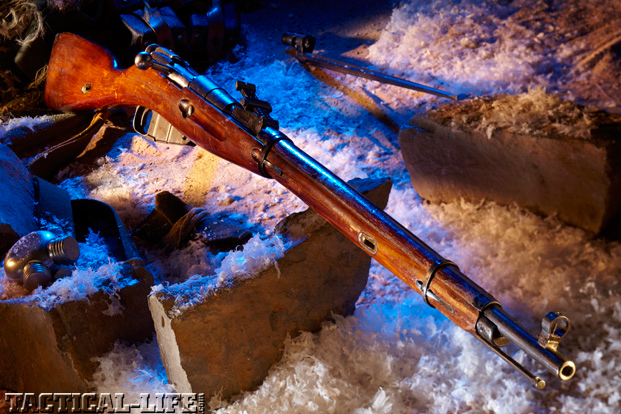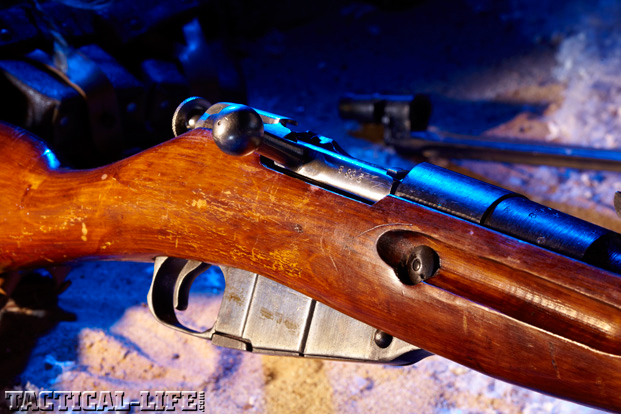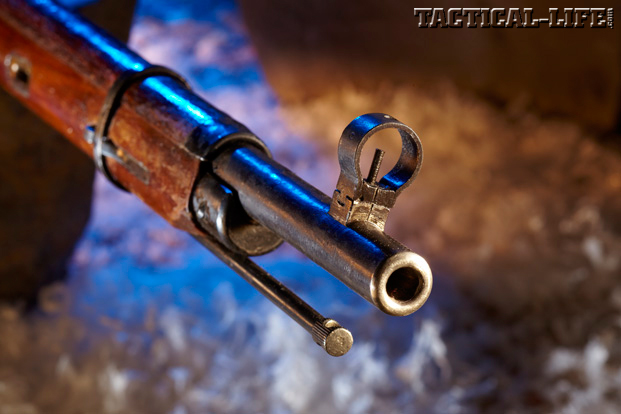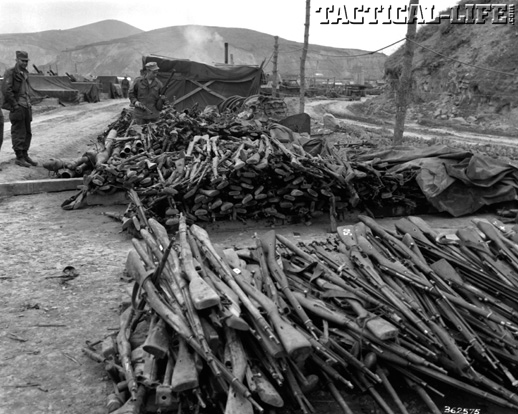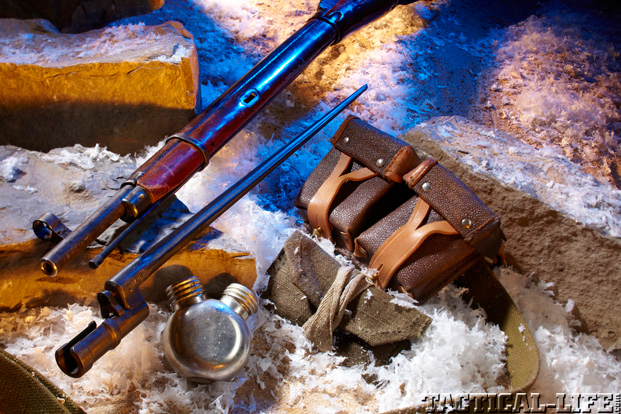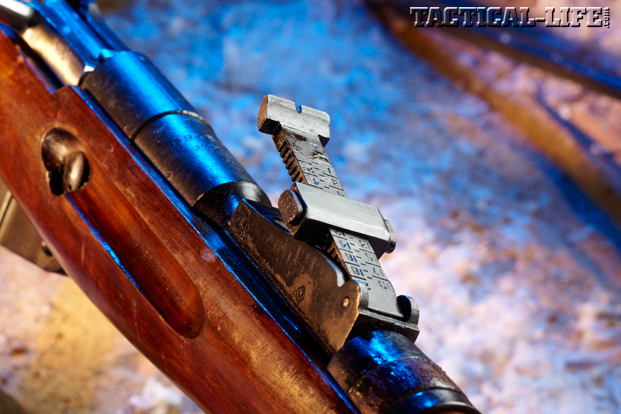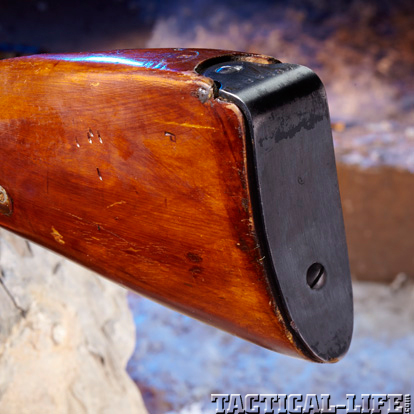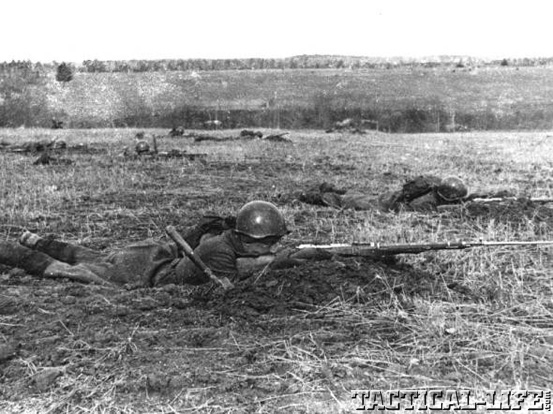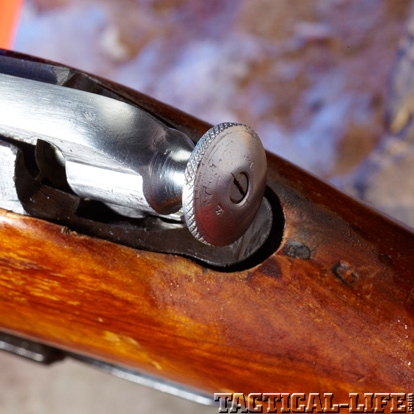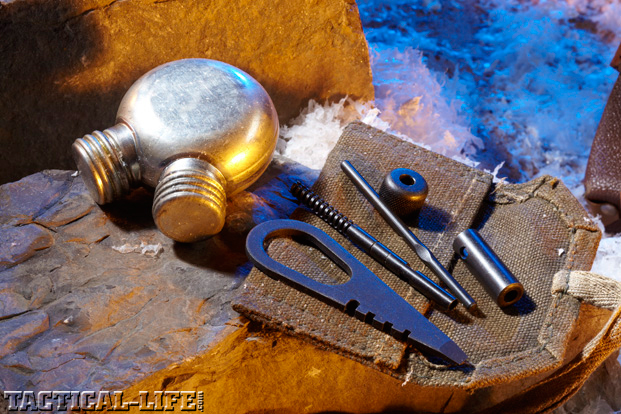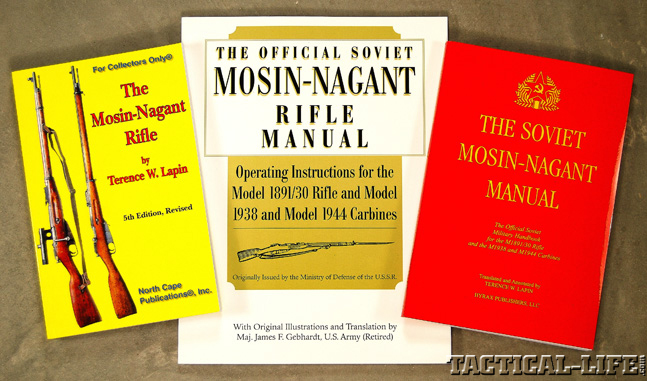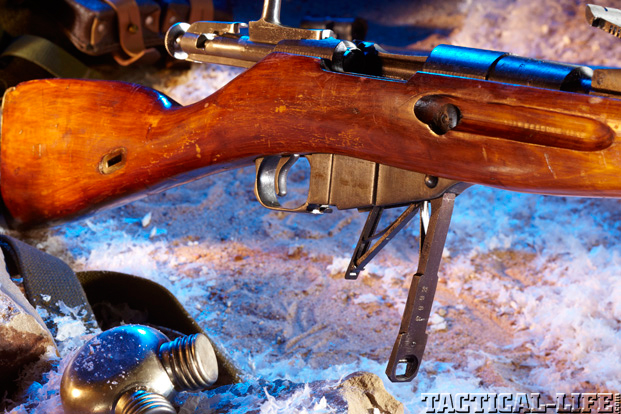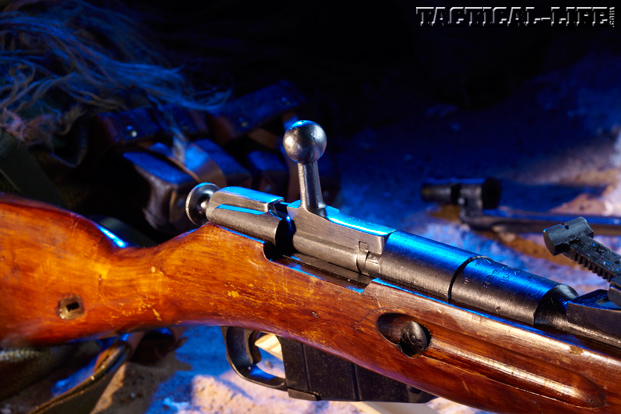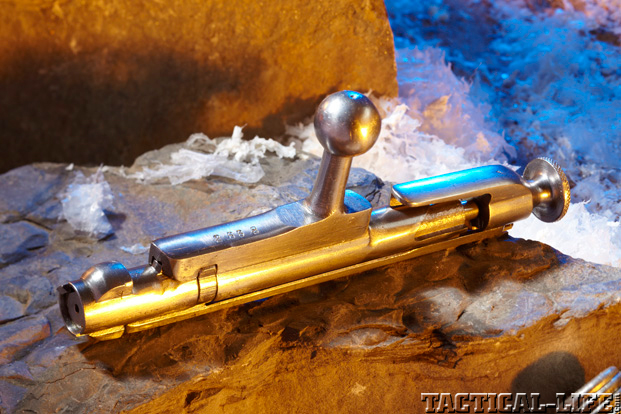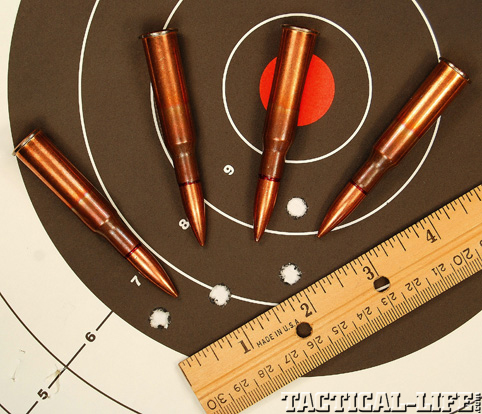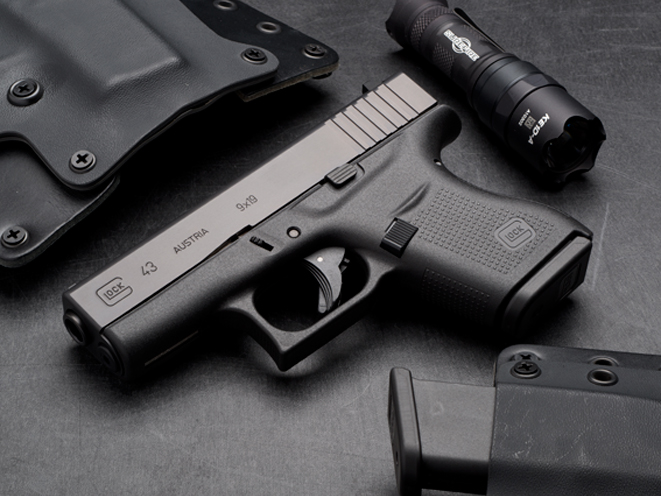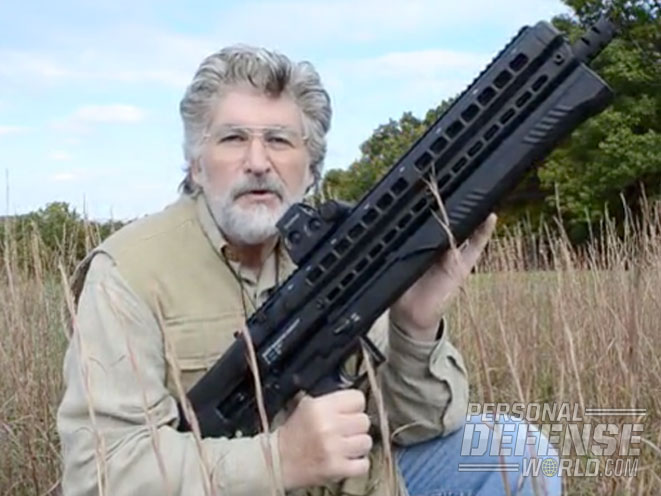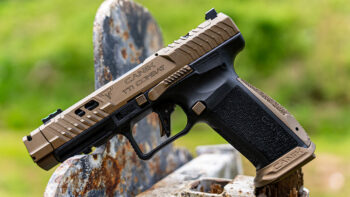The late 1800s were busy days in the progression of military armament around the world, and as that armament technology evolved, so did battlefield tactics. Arguably, the three most important factors in making war at the infantry level current at the last half of the 19th century were the production of reliable, self-contained metallic cartridges, the introduction of smokeless gunpowder and the development of a powerful repeating battle rifle.
Metallic cartridges allowed the soldier to carry ready-to-go, water-resistant ammunition. It was usable in all weather conditions, faster on reloading, and safer when reloading from covered or prone positions—shooters didn’t have to expose their torso when standing up—and it had the related, inherent advantages of the breechloader, as it assumed its place in battle-rifle evolution. Smokeless gunpowder allowed energy figures to remain high for extended ranges while bullet diameters and weights were lowered and made more efficient. Clouds of black-powder smoke—which, on calm days, often completely obscured the enemy during high-volume engagements—were no longer a dead giveaway (literally) of the shooter’s location. The repeating battle rifles could also fire longer between cleaning sessions without degradation in accuracy. Repeaters weren’t exactly new, but most had been relatively low-powered, slow-loading lever-actions that were unsuited to long-distance, pitched battles against organized armies.
There was, however, the occasional exception: The forces of Tsar Alexander III quickly discovered the superiority of the repeater when their single-shot rifles met Turkish soldiers armed with Winchester Model 1873s in the Russo-Turkish War (1877–1878). But the so-called Turkish experiment was only a side note in battlefield ordnance history: handgun-calibered lever actions were not heartily embraced by any other notable military power. Still, the concept of the repeater made an impression and not just among Russians: in 1886, France fielded their Lebel Model 1886; in 1888, Germany accepted the “designed-by-committee” Model 1888 Commission Rifle; and in 1889, Great Britain adopted the Lee-Metford, Austria-Hungary the Mannlicher, Switzerland the Schmidt-Rubin, and the U.S. the Krag-Jorgensen—all magazine repeaters. As smokeless powders were later perfected, ammunition and rifles were modified for increased efficiency and performance. Other nations created their own designs, with many being traded back and forth, but the epitome of the bolt-action battle rifle being Paul Mauser’s German Model 98, the mainstay of Kaiser and Nazi infantry elements through both World Wars. While we hear quite a bit about Mausers, British Enfields, U.S. Springfields and other military classics, there was another battle rifle that was fielded (in various forms) by a major power for over 60 years, one that has received little mention or respect in the world of martial hardware: the Mosin-Nagant.
Mosin-Nagant (1891–1930)
In late-1800s Russia, work was underway to replace the stocks of older and militarily obsolete rifles with newer equipment. Among the designs submitted for trial were two rifles: one from a young Russian Army captain named Sergei Ivanovich Mosin and the other from Belgian weapons designer Leon Nagant. In late 1890 and early 1891, both rifles were tested by three regiments and one battalion of the Tsar’s Army. Nagant’s rifle came out ahead. After some political maneuvering that suggested the final outcome was based more on “he’s not one of us” than on merit, the decision was made to go forward with a design that incorporated elements of both rifles. The majority of the rifle was of Mosin’s design, with credit usually given to Nagant for the magazine follower, the bolt and the charger clip. Alexander III reviewed the weapon in April 1891 and then approved it. Production began in 1892 at the Imperial ordnance factories in the cities of Tula, Sestroryetsk and Izhevsk, with a production goal of 3,290,000 rifles.
As with any new battle rifle, concerns emerged after shooters started using them—accordingly, several changes were made. Then, in 1910, the Mosin-Nagant began to split into three primary forms: the Infantry, the Dragoon and the Cossack. Each model was based on the same bolt action with a straight bolt handle, a five-shot internal capacity fed by charger clips, long-range rear sights graduated in an antiquated Russian unit of measurement called an arshin (equaling 28 inches), a front blade sight, a one-piece beech stock with a full handguard on top, a cleaning rod, sling stock slots, and a rudimentary safety that was engaged by twisting the large cocking piece slightly counterclockwise. Individual differences between the three rifle models were mostly in length and sights, and the Cossacks were not used with bayonets, which weren’t entirely practical when riding horseback. The initial round issued for the 1891 was a 7.62mm 210.4-grain round nose that showed severe limitations on the battlefield and was later replaced by a 150-grain spitzer bullet in 1908. Rear sights were calibrated in meters instead of arshini after the Russian Revolution (1917–1918).
The 1891 Mosin-Nagant was further refined, achieving in 1930 its best-known configuration with the 91/30 revision: The hexagonal receivers of the original rifles were changed to quicker-to-produce, less-labor-intensive round receivers (although hex rifles were still assembled until about 1936). There were also some continuing developments in small parts, such as bayonets, and in larger parts, such as the entire Model 1944 Carbine. The 91/30 Mosin-Nagant had a more maneuverable 28.7-inch barrel, replacing the original’s 31.6-inch barrel; a hooded post front sight, replacing the front blade; a tangent-type rear sight marked from 100–2,000 meters with a curved ramp base, replacing the older, stepped ramp base marked from 200–1,000 arshini and leaf-marked up to 2,600 arshini; simplified barrel bands with flat-stamped tongue-and-groove patterns; a two-piece interrupter/ejector, replacing the older, pre-1930 one-piece; a new, circa-1930 D cartridge with .310–0.311-inch bore diameters, increased from 0.300 inches; and a tapered, end-specific handguard, replacing the original 1891 reversible handguard. In addition to producing new rifles from start to finish in the 91/30 configuration, Russia took some older pre-1930 parts, such as the hex receivers, and used or adapted them to 91/30 form, until stocks ran out.
Across Continents
During the first half of the 20th century, the Mosin-Nagant was also used, modified, captured and in some cases built by several other nations such as Finland, Hungary, Poland, Romania, France, Bulgaria, Germany and China. Even the U.S. had built Mosin-Nagants pursuant to WWI-era contracts with Remington Arms and New England Westinghouse. There were so many Mosin-Nagants in inventory and use that today any number of variations can be found, with any number of national markings and a mix of older and newer parts and accessories. Russian stockpiles were re-arsenaled after WWII and mothballed as war reserves, which has added additional variations (such as those with post-war laminated stocks and pre-war parts) to the surplus market over the past 15 years.
The Mosin-Nagant, during all its years in service and well into the 1960s in some cases, has been considered an ugly lout (it is) and not particularly refined (it wasn’t) nor elegant (not by a long shot). But it was a robust and simple design that held up well for Mother Russia, in climates and conditions that could easily and completely shutdown other designs—the gun worked and kept on working.
Soldiers Afield
While Russian soldiers of the time have often been described as illiterate, poorly trained peasants who were unwillingly drafted into service, they were expected to be very proficient with their rifles. Their training manuals detail two methods of fire in combat: volley and individual. Volley-fire was done in squads under control of a superior, and it was the responsibility of that superior to determine the target (group or individual), accurately gauge the distance, tell the men exactly what rear sight setting to use, exactly what to aim at (enemy’s belt, horse’s chest and so forth), and exactly how many rounds to fire. For individual-fire, soldier’s were trained in several methods of determining range (by target size, target color, target detail and target lighting conditions), in leading a target, in adjusting aim for air-density variations in high and low altitudes, in adjusting elevation for varying temperatures, in dealing with crosswinds, in engaging aircraft and parachutists up to 500 yards and so on.
Russian soldiers were trained to be able to produce 10 aimed shots in 1 minute with acceptable accuracy. In battle, they were required to notify their superior officers when they reached their ammunition’s halfway point, to take ammunition from the dead and wounded when possible, to always keep a packet of 15 rounds in reserve that would only be fired with permission from above, and to not clean their weapons without supervision. Note that losing military cartridges was considered a criminal offense.
Battle Sight Zeroed
On entering service with a unit, each rifle was tested for zero. The rifle was usually fired in the presence of—but not by—the soldier it was issued to. Its accuracy and zero were checked by the unit’s best shooters, who fired them prone off a rest at 100 meters, with their left hands supporting the rifles on the rests and the rear sights set at “3” (300 meters). The rifle’s aiming point was the bottom edge of a black rectangle 30 centimeters tall and 20 centimeters wide (roughly 12 by 8 inches). In keeping with their training to aim at a belt buckle, the required mean point of impact was 17 centimeters (6.69 inches) above the point of aim, at that sight setting. Four shots were fired, and the rifle’s zero was considered “confirmed” or acceptable if all four fell inside a 15-centimeter (5.90-inch) circle, with the average center not diverging from the aiming point more than 5 centimeters (1.96 inches). In the case of a noticeable flier, allowances were made to pass with three shots. Adjustments on the rifles were made by unit-level armorers on the spot if the rifle didn’t print correctly, and records were kept on each gun.
All this, by the way, was done with the bayonet attached. Russian military higher-ups were firm believers in the bayonet: Very few scabbards were made or issued to Russian troops. There were two approved methods of carrying the bayonet: on the rifle or on the side of a cavalry saber’s scabbard that was specially built for piggy-backing the bayonet. The infantry bayonet was expected to be fixed at all times unless totally impractical. The only alternative to carrying it fixed in a battle-ready position was with it reversed on the left side of the barrel. This shortened the rifle’s overall length in cramped spaces like transport vehicles.
The Russians also strongly emphasized sight changes in conjunction with range estimation. Infantrymen were taught to determine distance, make the appropriate rear sight adjustment for the conditions, and then fire. They were not trained to use a holdover with a static, standardized setting. Interestingly, in volley-fire, part of the response to a ceasefire order was to immediately return the rear sight to the rear 100-yard position. In normal carry, the rear sight would be left there until an engagement and then adjusted for targets. Note that training in the classroom and on the range is always subject to modification in the field. While Russia’s primary doctrine apparently encouraged free use of as many sight graduations as possible, making constant elevation adjustments during the heat of battle as targets appeared at varying distances wouldn’t have been always feasible.
Downrange
With millions to choose from, finding a surplus Mosin-Nagant isn’t hard. The test sample used here, a 1943 Izhevsk 91/30 from Century Arms, came with a bag of accessories, including a bayonet, a sling, a double-sided steel oil/cleaner “bottle,” a post-war, naugahyde, dual-pocket cartridge pouch, and a cleaning kit wrapped in a canvas pouch that contained a muzzle protector, a cleaning jag, a two-part rod handle, and a screwdriver/firing-pin protrusion gauge. My Mosin-Nagant was in good shape overall: the steel was fine, and its bluing was intact; but the wood was shedding flakes of the old varnish, which had been applied before the rifles were stored in Russian arsenals (and stayed in them for over 50 years). After removing traces of cosmoline inside and out and thoroughly scrubbing the dark bore, I was off to the range to take the Mosin-Nagant out for 100-yard testing with two commercial 7.62x54R loads and some Russian surplus 147-grain FMJ boat-tail rounds.
Firing off a rest with the bayonet mounted, I started out sitting (not prone) with the rifle on the rest and supported by my hand, as the Russian manuals stated. I found I got tighter groups, however, with the stock laying directly on the rest. Firing four-shot strings, again trying to duplicate the Russian sighting protocols, I worked through the 147-grain surplus FMJs, then Winchester’s white-box, generic, 180-grain soft points, and finished up with Hornady’s 174-grain, boat-tail hollow points, using the 100-yard sight position. Many Mosin-Nagants tend to shoot high, but this one shot low, averaging 6 to 7 inches below point of aim and about 2.5 inches left. Repeating this without the bayonet (which had to be malleted on and malleted off again), the rifle still ran low, this time 3 to 5 inches below point of aim and 2.5 to 4 inches right. On this sample, the windage could be easily corrected by tapping the front sight assembly left or right as needed, and elevation by using a higher rear sight setting to bring impacts up.
The Russian surplus and the Hornady commercial loads both used steel cases. The rifle did not like the Hornady cases, frequently requiring the mallet again to open the bolt on extraction. One deficiency of the Mosin-Nagant design is the low-leverage, short bolt handle. Other notable quirks included a very long trigger pull and a tendency for the handguard to wander forward under recoil. (Three quick tips: use black, heat-shrink, wire-insulation material cut appropriately to make the front post taller and lower the point of impact; use a small pin punch through the hole in the handguard to push the rear barrel-band retaining spring slightly out of the wood, just far enough to create more tension on the barrel band when anchoring the handguard; and keep the two action screws tight.)
Accuracy-wise, the Mosin-Nagant’s groups would have passed military trials, with the bayonet mounted and with all three loads, but not with the Winchester soft points and a rifle sans bayonet. In 95-degree weather under direct sunlight, the copper-washed, Russian “sardine can” surplus ammunition clocked a very nice standard deviation of 5 fps, along with the highest velocity of the three loads. Remember to clean the bore and bolt face soon after using corrosive surplus ammunition, and use something that removes the salts left by the primers—I use Windex with vinegar—followed by your normal cleaning routine.
Wild Past
Mosin-Nagant history is rich, variations are plentiful and confusing, and the Soviet government manuals are a fascinating glimpse into the Mosin-Nagant’s life on the battlefield. Both The Official Soviet Mosin-Nagant Rifle Manual by James Gebhardt (Paladin Press, 2000) and The Soviet Mosin-Nagant Manual by Terrence Lapin (Hyrax Publishers, 1999) are translations of USSR Ministry Of Defense manuals. The Mosin Nagant Rifle by Terrance Lapin (North Cape Publications, 2010) is an excellent guide to the rifle’s development, models, specs, identification marks and individual parts evolution and nomenclature. These books are available from various sources (including amazon.com) and worth every dime.
The Mosin-Nagant in any of its common surplus forms is one of the few remaining classic military bargains left, commonly running anywhere from $99 to $150 and in very shootable form. Check locally at sporting goods stores and gunshops. Century International Arms is one of the largest importers (centuryarms.com; 800-527-1252).









